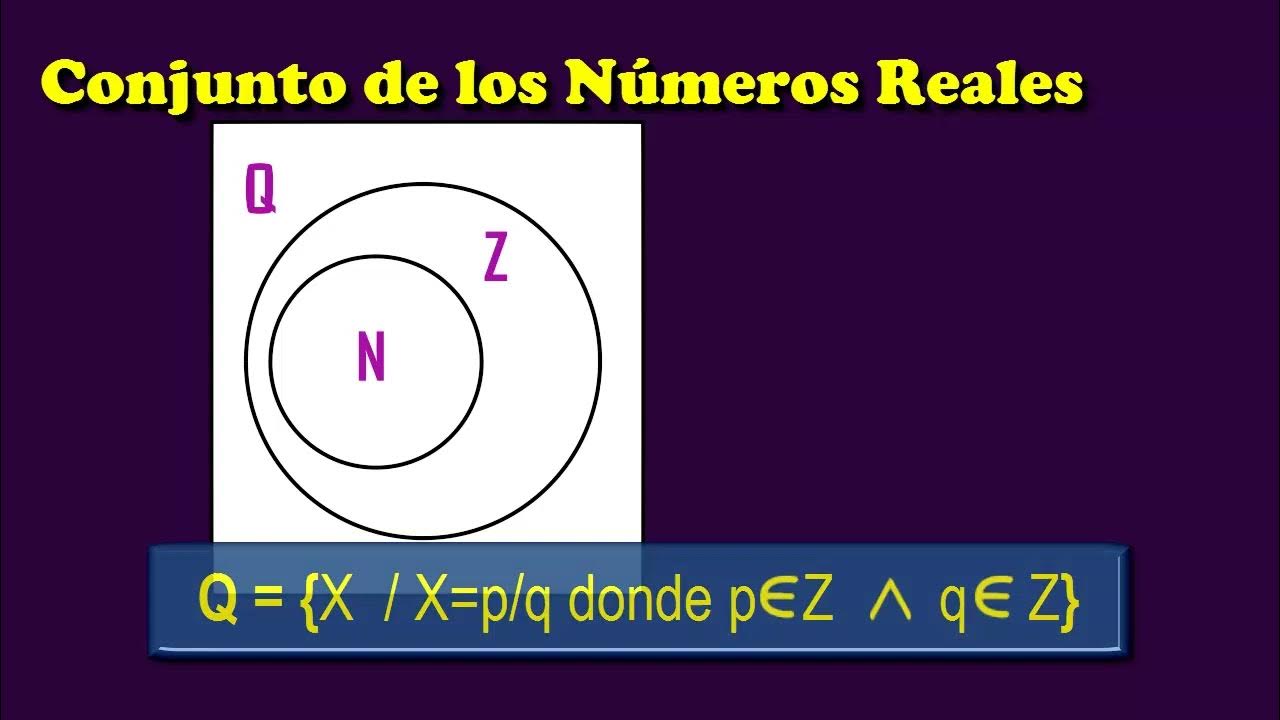Clasificación de los Números Reales
Summary
TLDRThis video explains the classification of real numbers into two major subsets: rational and irrational numbers. Rational numbers can be expressed as fractions or decimals, and include integers and natural numbers. Integers are numbers without remainders, while natural numbers are used for counting, starting from 1. Irrational numbers, such as pi and the square roots of non-perfect squares, cannot be expressed as fractions and have infinite, non-repeating decimal expansions. The video provides an in-depth understanding of these classifications, helping viewers identify and categorize numbers within the real number set.
Takeaways
- 😀 The lesson focuses on the classification of real numbers and the identification of various subsets within the real number set.
- 😀 Real numbers can be divided into two main categories: rational and irrational numbers.
- 😀 Rational numbers are those that can be expressed as the quotient of two integers, i.e., fractions, and can be either positive or negative.
- 😀 Some examples of rational numbers include 3/4, -8/4, and 10/2, all of which can be expressed as exact fractions or decimals.
- 😀 Numbers like 0.75 or 1.2 are also rational because they can be written as fractions (3/4 and 6/5, respectively).
- 😀 Rational numbers can also be represented in decimal form, with terminating decimals (like 0.75) and repeating decimals (like -1/3 = 0.333...) being examples.
- 😀 A subset of rational numbers, called integers, include numbers like -4, -3, -2, -1, 0, 1, 2, etc., and these can be positive or negative whole numbers.
- 😀 The natural numbers, represented by 'N', start at 1 and include all positive counting numbers (1, 2, 3, 4, etc.), but do not include zero or any negative numbers.
- 😀 Irrational numbers are those that cannot be written as fractions and include non-repeating, non-terminating decimals like pi (π) or the mathematical constant e.
- 😀 It's important to distinguish irrational numbers from numbers like the square root of 4, which equals 2 and is a rational number, not irrational.
- 😀 All real numbers are categorized into subsets such as natural numbers, integers, rational numbers, and irrational numbers, forming the complete set of real numbers.
Q & A
What are real numbers?
-Real numbers are any numbers that exist, except for the square roots of negative numbers. These include rational and irrational numbers.
What are the two main subsets of real numbers?
-The two main subsets of real numbers are rational numbers and irrational numbers.
What defines a rational number?
-Rational numbers can be expressed as the quotient of two integers, meaning they can be written as fractions, and they can be either positive or negative.
What are some examples of rational numbers?
-Examples of rational numbers include fractions like 3/4, 6/5, -8/4, and 10/2. These can also be represented as decimal numbers, such as 0.75 or 1.2.
How are integers different from rational numbers?
-Integers are a subset of rational numbers where the fractions simplify to whole numbers, including negative numbers and zero, without any remainder.
What are integers?
-Integers are numbers that include all positive whole numbers, their negative counterparts, and zero. They are denoted by the letter Z.
What are natural numbers?
-Natural numbers are the positive whole numbers starting from 1 and are used for counting. They are denoted by the letter N.
How are natural numbers different from integers?
-Natural numbers are a subset of integers, excluding negative numbers and zero. They are used for counting objects or quantities.
What defines an irrational number?
-Irrational numbers cannot be expressed as fractions and have non-repeating, non-terminating decimal expansions. Examples include pi (π), the number e, and square roots of non-perfect squares like √2.
How can we distinguish between rational and irrational square roots?
-A square root is irrational if the number inside the square root is not a perfect square. For example, √2 is irrational, but √4 is rational because it simplifies to 2.
Outlines

Esta sección está disponible solo para usuarios con suscripción. Por favor, mejora tu plan para acceder a esta parte.
Mejorar ahoraMindmap

Esta sección está disponible solo para usuarios con suscripción. Por favor, mejora tu plan para acceder a esta parte.
Mejorar ahoraKeywords

Esta sección está disponible solo para usuarios con suscripción. Por favor, mejora tu plan para acceder a esta parte.
Mejorar ahoraHighlights

Esta sección está disponible solo para usuarios con suscripción. Por favor, mejora tu plan para acceder a esta parte.
Mejorar ahoraTranscripts

Esta sección está disponible solo para usuarios con suscripción. Por favor, mejora tu plan para acceder a esta parte.
Mejorar ahora5.0 / 5 (0 votes)






